



Fruit of the Elaeis guineensis (oil palm), a palm that provides an oil used in the manufacture of soap, candles and lubricants, as well as edible palm hearts.
Millions of households in the developing world depend on food and fodder from forests to supplement their own and their livestock's diets. Although forest foods do not usually provide a complete diet, they do make a critical contribution to the food supply. Forest foods increase the nutritional quality of rural diets; supplement other sources of food -particularly agricultural crops that are only seasonally available; and are used as emergency food supplies during drought, famine and war.
Forest foods are nutritionally important and are traditionally used as supplements to the staple diet. Leafy vegetables and wild animals add diversity, flavour, vitamins and minerals to characteristically grain-dominated diets. Forest foods are often collected and stored for later use. Forest foods can thus raise rural peoples' nutritional intake by providing a year-round supply of food.
The most important and well documented use of forest foods is in meeting seasonal shortfalls such as the `hunger periods' at the beginning of the rainy season before crops are ready for harvest. During hunger periods, the practices of digging for roots and tubers and gathering fruit and nuts are almost universal. Other gaps in food supply are caused by sudden needs for cash-for school fees, for example -which force families to sell crops. Such demands leave families short of both food and the money they need to buy food.
Trees are also important in emergencies such as drought and famine. They provide food when crops fail and products such as gum arabic to sell for cash income with which to buy food. Energy-rich foods such as the roots of the baobab tree are most sought after in times of famine, while other foods, such as the baobab's fruits, are often eaten during periodic shortages of staple foods. Several wild foods are used only in times of scarcity and famine, among them fibres, seeds, tubers, leaves and stems.

Roots -a highly calorific forest product but one that often requires lengthy preparation time and cooking.
Many of these famine foods have a high protein and energy content.
In India, Malaysia and Thailand, about 150 plant species, representing nearly one-fifth of the wild species consumed as food in these countries, have been identified as sources of emergency food crops, among them bark, kernels and tubers.
The role forests play in providing and maintaining suitable conditions for wildlife should not be under-estimated. Forested areas, mangroves, streams and fallow agricultural areas within the forest provide a habitat for many wild animals and fish. For, example, forests maintain suitable conditions for fresh water fish by helping to reduce the sediment in streams, while mangroves provide an important habitat for fish (see box).
Birds, their eggs, insects, rodents and other larger mammals are sometimes the only source of animal protein for rural people. The naturally abundant small animals-rats, squirrels, mice, porcupine and grasscutters - are the most important species for subsistence consumption.
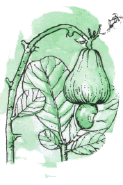
The cashew nut -another nutritive forest product; one that is easy to collect and roast.
In some regions, wild game consumption is extremely important. For example, in West Africa the consumption of bushmeat depends largely on availability. In Nigeria, people living near forest reserves consume as much as 84 percent of their animal protein in the form of game whereas, in areas of Nigeria with no access to forests, bushmeat makes up only 7 percent of total meat consumption. Similarly, in some areas of the Peruvian Amazon, people obtain more than 85 percent of their animal protein from wild animals, including fish.
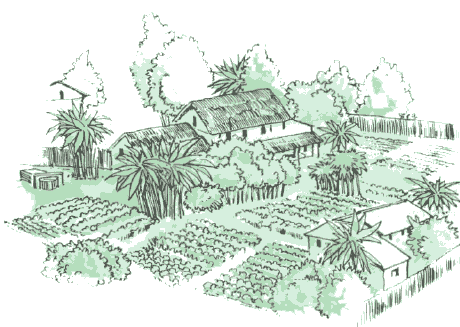
A homegarden in southeast Asia, where the production of protein and calories per hectare typically exceeds those of most field crops
Homegardens are producing an increasingy important supply of food in many countries, as population pressures reduce the amount of land available to each household for food crops. Homegardens support the cultivation of multi- purpose trees and shrubs, often in association with annual and perennial agricultural crops and livestock, within the household compound. Such gardens are found in most regions of the tropics and sub-tropics, particularly in lowland areas with high population densities.
Many homegardens resemble those of Java or southeastern Nigeria, with an intensive combination of trees, crops and livestock. In other cases, however, a single mango tree provides a source of food at a time of the year when few other foodstuffs are available or when the need to plant the next season's crop means that there is little spare time or labour available for gathering and preparing food.
The average size of a homegarden is usually much less than one hectare, yet in many parts of the world the fruit, nuts, edible leaves and other foodstuffs grown in homegardens provide a substantial part of the household food requirement. In some areas of Java, homegardens provide more than 40 percent of the total calorific intake of farming communities.

The mango-typical fruit found in homegardens in Asia, Africa and South America.
Gardens within a household compound can produce food all year round with a relatively low labour input. When intensively managed,
the yield from a compound, in monetary terms, can be five to ten times as much per hectare as that from traditional field cropping systems, and returns on labour are typically four to eight times higher.
Many homegardens support very large numbers of different species. In southeastern Nigeria permanently cultivated compounds around the household contain trees including the oil palm, coconut, banana and plantain, intercropped with cassava, gums and other arable crops.
Studies have shown that households with homegardens have higher than average nutrition levels. In Puerto Rico, for instance, food from gardens tended by women significantly contributes to the total food supply and is an important source of both betacarotene (converted to Vitamin A in the body) and Vitamin C, especially for children.
Trees are also part of traditional shifting cultivation systems practised within forest areas by more than 300 million people world-wide. Shifting cultivation can involve clearing forest areas to develop agroforestry systems similar to those found in homegardens. Trees are maintained or grown to provide a range of fruits, seeds, nuts and leaves for food as well as to maintain suitable soil conditions for food production.

Young boy from Niger climbs a fodder tree in the bush in a search for additional food for his sheep and goats. Fodder, whether browsed or gathered and stallfed, increases milk and meat production, strengthens draught animals and leads to the production of natural fertilizer.
An adequate supply of livestock fodder is a crucial part of food production for millions of people. Good fodder increases livestock productivity, making more milk and meat available for rural families; it helps maintain animals used in working the land; and it provides manure for fertilizer.
A reliable supply of fodder is critical to the 30 to 40 million pastoralists world-wide. There are 20 to 25 million pastoralists in Africa alone, many of them roaming the dry sub-Saharan belt that stretches from Mauritania to Ethiopia.
These pastoralists manage to keep their herds alive on arid and semi-arid land by supplying them with twigs, leaves, small branches, seed pods and fruit from trees and shrubs. Pastoralists in parts of northern Senegal, for example, rely on high-quality supplements of browse-leaves, fruits and seed-pods from trees and shrubs-for at least six months of every year, to keep their herds alive and healthy. Probably as much as three-quarters of Africa's nearly 10 000 tree species are used for browsing.
During the dry season, browse can comprise as much as 60 percent of goats' fodder and 30 percent of cattle fodder. Fodder from trees and shrubs is particularly important during this season when the nutritional quality of grasses is markedly reduced. Dry grasses contain only minimal levels of energy and protein, and lack essential minerals, especially phosphorus. For this reason, herders in Sahelian West Africa try to avoid pastures with no shrubs or trees.
Unfortunately, fodder supplies are coming increasingly under threat as pressures on tree fodder cause overbrowsing, reduce the regeneration of trees and shrubs, and in many places actually eradicate them.
In the Sahel, overbrowsing has led to a decline of the fodder species Acacia seyal (Whistling Thorn) and Acacia senegal (Gum Arabic tree). In the central rangelands of Somalia, Cordeauxia edulis (yicib), the main dry season food of camel and goat herds, is being overbrowsed and progressively eliminated.
The management of fodder resources on farms, in rangelands and in forest areas can help reduce overbrowsing and provide a sustainable source of animal fodder. A ready supply of fodder means that women, often the principal fodder providers, do not have to travel so far to find this necessity. The extra time and energy thus acquired are highly valuable, especially as women also prepare the family meals and often have a working day that lasts from four in the morning to eleven at night.
Many Nepalese farmers have now started to grow fodder trees on their farms, and they are popular on farm and fallow land in southeast Nigeria. Cattle, sheep and goats are not the only animals to benefit. In western Java, trees provide up to 15 percent of the fodder used to feed small stall-fed ruminants.
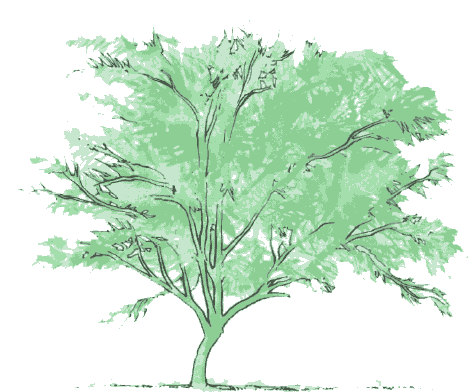
Prosopis chilensis, (Chilean Mesquite) originally imported from South America, but now commonly grown in Africa. Not only does it provide nutritious fodder but the wood can be used to make poles, stakes and other agricultural items.
Livestock productivity can also be increased on rangelands through greater use of tree and shrub species. Species with particular potential in arid areas of Africa are Opuntia and Atriplex nummalaria; in Latin America, Prosopis species (Mesquites) have shown their worth in maintaining livestock health and productivity.
Managing the growth of naturally occurring fodder species or planting more palatable plants to replace woody shrubs and trees is another way to improve rangeland production. In the Sahel, many degraded pastures could be improved by controlling the unpalatable Calotropis procera, now especially common around boreholes. In large areas of Turkana in northern Kenya, Acacia reficiens has rendered the rangeland impenetrable to animals. In both regions, control of the unpalatable species, linked with re-planting of more useful species, would enhance conditions on the rangeland and enable these lands to support a greater number of animals.
Agroforestry can also play an important role in providing fodder for livestock, whether from hedges and windbreaks established to stabilize sand dunes and allow more cropping, or from the variety of trees cultivated in homegardens. In either case, incorporating th provision of fodder into the agricultural syster has significant spin-offs for the welfare of the household.
Food from trees in forests homegardens, and the plants and wildlife supported by forests are often nutritionally essential to the diet of rural people. The medicinal and other properties of tree products also play an important role in keeping people healthy.
Many forest foods are higher in vitamins and other important nutrients than domesticated varieties. While the vitamin C content of an orange is famously high at 57 mg/100 g, the fruit of the baobab tree has 360 mg/100 g and Ziziphus jujube var. spinosa 1000 mg/100 g. Similarly, on a weight-for-weight basis, wild leaf vegetables contain more riboflavin-another vitamin necessary for good health -than eggs, milk, nuts and fish.
It is estimated that some 250 000 children go blind in south-east Asia every year because of lack of vitamin A. Many forest fruits and their leaves are good sources of beta-carotene, which the body converts into vitamin A. Riboflavin deficiency, responsible for several eye and skin disorders, can be corrected by many forest foods, especially leaves. Iron, needed to produce blood haemoglobin, is abundantly available in many forest foods.
One of the most common causes of dietary deficiencies is the decreasing diversity of diets. Medical surveys have shown that Pacific Islanders, for example, began to consume fewer minerals and vitamins as they became more dependent on imported cereals and developed a preference for introduced vegetables; there was a significant decline in health as a result.
In rural Bangladesh it was found that, although people living in `'modern' villages had calorific, protein-rich rice and wheat available all year round, a greater number of people suffered from malnutrition than in `traditional' villages where food was not as readily available. Because of the availability of rice and wheat, the modern villagers were eating less of other foods, and the diet of traditional villagers, which contained more roots, tubers, pulses and vegetables, had a higher mineral and vitamin content.

Traditional medicines, such as the eucalyptus oil used as a decongestant, are important in the food economies of many families: they promote good health and hence improve nutrition.
As well as making a direct contribution to health by improving nutrition, tree products provide the only medicines available to many people in developing countries. Some plants contain high concentrations of chemicals used as the base for modern drugs. Many plants are used traditionally for these medicinal qualities, and others undoubtedly depend on effects not yet exploited in Western medicine. These medicines are important nutritionally. By keeping the body healthy, they not only help it to absorb food efficiently but also increase its ability to fight off infections that might otherwise impair digestion and the ability to eat.
Some trees have specific properties that can improve the quality of water supplies. Moringa species, for example, are used by women in Egypt to clarify turbid water. The tree's seeds contain natural coagulants which can clear water to tap water quality in one to two hours, and eliminate up to 99 percent of bacteria. The fruits of other species are lethal to the snails that act as intermediary hosts of bilharzia, and the water fleas that harbour the guinea worm.
Wild leaves, either fresh or dried, are one of the most widely consumed forest foods. As the base for soups, stews and relishes they add flavour to otherwise bland staples such as rice or maize, making them more palatable and thus encouraging consumption. One study in Lushoto, Tanzania, found that people who consumed wild leaf relishes favoured the taste of wild leaves over introduced cultivated vegetables.
Leaves from wild and cultivated trees are often boiled fresh in stews. They can also be dried and powdered, or fermented, to preserve them; they can later be made into a paste which is used in stews and soups as a meat substitute.
The carotene, vitamin C, calcium and iron content of leaves varies greatly. One study in Swaziland found that the nutrient content of wild leaves compared favourably with that of the leaves of cultivated plants. In Swaziland, the leaves of 48 different species are used; and at least half the adults eat meals which include wild leaves more than twice a week.
The stem of the sago palm contains starch, a valuable carbohydrate, commonly used in cooking in Indonesia. It contains 352 calories/ 100 g and provides 85 percent of the energy intake of people in the rural area of Upper Sepik, in Papua New Guinea.
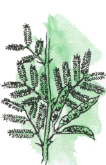
Leaves are widely used in rural society as spicy supplements to stews and soups and often have a high nutritional value.
The nuts of the coconut, oil palm and babassu palm are at the forefront of nutritionally important nuts and seeds, adding substantial calories, oil and protein to the diet.
(Nutritionally, fats and oils are important for several reasons, not least because they facilitate the absorption of vitamins A, D and E.)
Coconuts are of central dietary importa in many cultures, and account for 7 percent the world's fat consumption. In the areas of northeastern Brazil where the babassu palm grows, its kernels provide oil for an average percent of households. In Sierra Leone, oil from the kernel and fruits of the oil palm is consumed by 96 percent of rural households.
Among other important oil nut trees are, the shea butternut, cashew nut, African breadfruit, the mongongo nut and the Park species. The seeds of Parkia form an import part of the diet in most parts of the Sahel. Fermenting Parkia improves the digestibility the protein and increases the vitamin content of the seeds, providing a nutritious protein fat-rich food known as dawadawa. It is an important ingredient in side dishes, soups a stews made to accompany porridges in northern and western Africa.

The baobab tree is heavily used in Africa as a source of fuelwood, food, oil and even dug-out canoes. The fruit pulp can be dried to produce cream of tartar, and the leaves are added to stews and soups as a nutritious spice.
Roots and tubers provide carbohydrates an( some minerals, and are often important ingredients in traditional medicines. They used as drought and famine foods, not only because they survive low rainfall periods, b because they can be an important source of water. However, they require time to find a dig up, and often involve extensive process such as soaking and prolonged cooking.
Mushrooms, eaten as meat substitutes and i flavouring, are good sources of protein and minerals. In an analysis of the nutritional values of 30 edible mushrooms from Upper Shaba, Zaire, the mean protein content was found to be 22.7 g/100 g dry weight, with a high calcium and iron content.
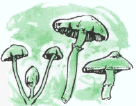
Mushrooms are nutritious as well as tasty-one study found that 30 species had a high protein value of 22.7 g/100 g as well as high calcium and iron contents.
Sap, high in sugars and minerals, is tapped beverages. Gum, used as a food supplement good source of energy; and both saps and g, have many medicinal uses. Palm wines froc fermented sap are an important cultural beverage in many areas. For example, in southern Cameroon the wine is consumed in most households several times a week. The gum of Sterculia species, a good source of beta-carotene and vitamin C, is added to soups and stews in northern Senegal. Gum arabic (from Acacia senegal) is a traditionally important food for pastoralists, agriculturalists and hunter-gatherers; more recently it became an important source of food for gum collectors. Less than 200 g have been estimated as sufficient to feed a person for a day.
Honey is highly valued almost everywhere for its high energy content: 100 g of honey contain more than 280 calories. Tree blossoms provide a year round food supply for bees and, in turn, the fertilizing action of bees during their hunt for nectar can increase the yields of oilseed, pulses and fruit trees.

Honey is an important source of energy almost everywhere. Hives placed in orchards bring additional benefits by increasing fruit yields.
Forests help to maintain the conditions in rivers necessary for fish to live and breed. In coastal areas, mangrove forests are home to important breeding areas for fish and molluscs, which together provide significant animal protein for many rural communities. Average figures for Nigeria, for instance, show that more than three times as much fish as beef is eaten. In Sarawak, Malaysia and the Peruvian Amazon, 50-60 percent of animal protein comes from fish.

Fish often constitute 60 percent of the animal protein consumed by rural people living in coastal areas. Mangrove swamps are still among the most important sources of fish and shellfish.
The protein content of wild meat-often 20-25 percent by weight-is comparable and sometimes higher than that of meat from domestic animals. Wild meat is an important source of animal protein in many parts of the world, though availability depends on conditions in the forest. Although wild meat is also a good source of iron and vitamins A and B, which are commonly lacking in diets, often only small amounts of meat are consumed because of shortages, high prices and legal restrictions on the hunting of animals.
The protein and vitamin content of insects such as caterpillars has been compared to that of vitamin pills. Studies found that 100 g of termites provide 561 calories, and that bee larvae contain 10 times more vitamin D than fish liver oil and twice as much vitamin A as egg yolk.